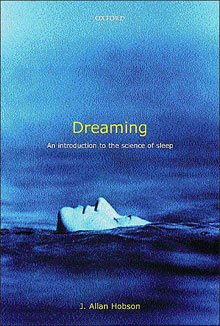Book Notes
 J. Allan Hobson, Dreaming; An Introduction to the Science of Sleep (Oxford: Oxford University Press, 2002), 168pp.
J. Allan Hobson, Dreaming; An Introduction to the Science of Sleep (Oxford: Oxford University Press, 2002), 168pp.
Forget Freud. Save any money you might spend on the couches of his psychoanalytic priests who divine sophisticated interpretations of the content of your dreams. In this slender volume Hobson, a professor of psychiatry at Harvard Medical School who specializes in sleep research, uses the latest in neurobiology to supercede what he considers the "scientifically naive and flawed ideas" of the psychoanalytic tradition of the ostensibly hidden meanings of dreams. Instead of chasing content analysis as the holy grail of dream theory, he proffers what he calls a formal analysis of dreams. Dream content varies from person to person, but their formal properties are virtually identical in everyone —emotional salience, perceptual or visual vividness, bizarre logic and cognition, and difficulty in recall.
In the Freudian tradition a person's dream is precisely not what the dreamer experiences it to be; instead, it is an encoded, veiled, and mysterious message that must be decoded (for a price, of course). Dreams are unconscious or repressed desires that bubble up when the ego is asleep. There is, thus, a separation between the dreamer and the dream, the brain and the mind, the ego and the id. Hobson dismisses this Freudian analysis of dream content as a "hopeless fantasy," and he admits that he wants to "discredit Freud emphatically." To do this he proposes the unapologetically reductionistic notion that the mental mind-physical brain is one and the same thing (or, our minds are "functional states of our brain"). Dreaming, then, is nothing more or less than the spontaneous, self-activation of the mind-brain during sleep. Why the brain self-activates just so, we do not know. Nor can we be sure about any purpose of such neurological functions, if there are any. The difference between waking and sleeping is one of brain chemistry, our mental state being "a constantly negotiated compromise between the poles of waking sanity and dreaming madness." Thus, "we do not dream because our unconscious wishes or drives would, if undisguised, wake us up. We dream because our brains are activated during sleep."
Hobson uses a number of examples from his own dream journal to illustrate his points, along with sleep lab reports from science research, and home-based reports. One feature that I especially enjoyed was the nine "sidebar" boxes that interact with common, popular questions. Do animals dream? Probably. Do we dream in color? Yes. Do blind people see in their dreams? It depends. Are men's and women's dreams different? No. Hobson has also done a fine job avoiding academic jargon; he writes in an unusually accessible style. If Hobson is right that Freud is wrong, I find it comforting to know that any number of my "bad dreams" can be explained by simple brain chemistry rather than by foreboding, speculative and expensive interpretations by so-called experts.


